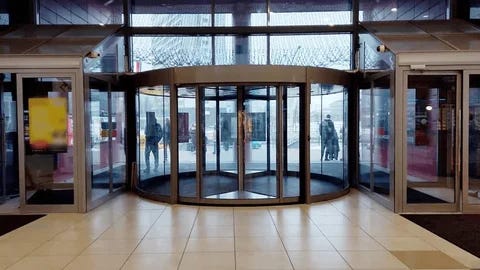Have you ever been in a crowded hallway at school, a mall, or a movie theater? Have you noticed how people weave around each other constantly yet somehow avoid collisions? It turns out that there is a hidden logic to how we move around when we are in a crowded space. A group of people who were math nerds when they were kids, and then decided to become researchers when they grew up, got together at this institute called MIT. They decided to observe how people move in crowds. It was very boring in the beginning. People, like dots in a video game, were moving around in many random ways. The researchers yawned and scratched their heads, nearly giving up on finding anything useful. Like all good researchers do, they kept note of their observations in large notebooks with their findings scribbled in pencil. Slowly and steadily, they found two rather fascinating things about how people move.
People maintain their natural pace. Every person has an individual pace. Even when walking in crowded spaces, nobody changes their speeds to match that of others. The only times they change their speeds is if they are forced to slow down.
Every person is constantly changing their paths to avoid collision. Our brains are unconsciously calculating tiny changes to the way we should move, so we do not touch or bump into anyone in a crowd. This is no different from how a car or a plane on autopilot works.
But there is an exception to these. They apply when we're in our "happy zone." The moment panic sets in—whether from fire, threats, or other emergencies—all these mathematical rules fly out the window. Suddenly, we behave like madmen, trampling each other for the nearest exit.
Here's the embarrassing part: fish and birds follow these same mathematical rules when moving through water or air, just like humans in crowded spaces. But unlike us, when facing distress (like birds encountering smoke or fish navigating a predator or a fisherman’s nest), these creatures don't panic. They maintain their normal movement patterns and often escape harm's way without causing chaos among themselves.
The researchers at MIT then sat down and wrote a long essay that was then published for all the world to read. Their interesting findings about how people move in crowds has now become quite popular with architects and designers. They plan to use these findings to design safer stadiums, more efficient airports, and obstacle-free sidewalks. Engineers are planning to use it to build better emergency exits for malls and theatres to prevent deadly stampedes. Even Elon Musk’s robots will (maybe) stop running over pedestrians.
That said, we’ve all learned one universal truth from this research: In a crisis, be the fish.
Every week on the Lighter side, I write about one news story that I find interesting. As I comb through the news jungle, I stumble upon stories of countries that are squabbling, corporations that are bragging about their profits, underdog soccer teams winning trophies and occasionally some eccentric billionaires buying a fruit for a million dollars.
But this time, when I read about this piece of Math based research, my eyes lit up. For those of you that thought Math was mostly about annoying word problems (a.k.a if Ramesh buys 312 pomegranates at ₹6.4 each……), it looks like Math solves some real problems too. Here’s the full scoop on the research and there’s some interesting insights for us on how to escape panicking crowds. Read on!
Tell me from the beginning please.
At first, the MIT team bought their morning cup of coffee, assembled at a park and sat under a tree thinking about what they should do for the day. And then, someone looked at the rush-hour crowd going to the nearest railway station and wondered aloud ‘hmm..I wonder if there is any difference in the way these people walk in a railway station from the way these leisurely strollers walk across the park!’ With the coffee cups drained in their throats and an idea taking root in their minds, they ran to their research labs. They wanted to get their hands on recorded videos of real-world crowds in train stations, airports and shopping malls. It turns out that if you are Math researcher at MIT, you can just about get data on anything. And then, the videos arrived at their desks. I am making all of this up. I don’t know if the researchers had coffee at the park, but they certainly got their videos of people moving across crowded spaces, from various government departments. Then, they set down to work.
They documented how people walked, WHEN they slowed down, and how they changed their direction to avoid collisions. People weren't just zigzagging chaotically—they were making small and subtle changes in their directions, all the time. These adjustments were intelligent and allowed the entire crowd to move without causing any traffic jams, even inside crowded train stations. That’s when the researchers were able to observe two rules that all walkers followed.
Rule #1: Maintain Preferred Speed
Each person has a natural walking pace—some stroll while others speed-walk. Unless obstructed (like when someone cuts in front), individuals stubbornly maintain their preferred speed.
Rule #2: Automatic Collision Avoidance
Our brains make microscopic adjustments to prevent collisions without conscious thought. The brain is calculating constantly about things like - "That person is 3 feet away—I'll turn 10 degrees left." It happens instinctively, like breathing.
Next, the researchers connected these two rules to Physics.
The team sat down to use their knowledge of this crowd behaviour to see if they could develop a mathematical equation that would predict how 10,000 people would move through a mall in an hour. The team recognised that human crowds behave the same way as physical particles—similar to marbles rolling in a box or molecules bouncing in air. They developed their mathematical equation to predict the movement of 10,000 people based on how scientists would predict the behaviour of 10,000 molecules inside a balloon. But, they saw that humans did differ from molecules in two ways.
Purpose: Humans move with intention (towards a boarding gate in an airport of a coffee shop in a mall etc.). Particles on the other hand move around aimlessly. Molecules of gas moving inside a balloon don’t exactly have a destination in mind.
Politeness: Humans don’t like to bump into each other. They actively avoid collisions. Whereas particles collide freely. They have no social rules.
The researchers then decided to add these two factors to their mathematical equations (being polite / having a goal) and then predict how those 10,000 people would move through a crowded space. This final mathematical model included the following:
a) Natural Speed: People (just like particles) were assigned different values for their speed (e.g., 2 m/s for slow walkers, 3 m/s for fast walkers)
b) Reaction Time: Different people react differently to adjust their speed or direction of walking if they see someone coming towards them. This is typically 0.5 seconds (it could be 0.6-0.8 for people with slower reaction)
c) Personal Space: People like to maintain a bubble space around them. This is usually 0.6-1 meter.
The mathematicians tested if their models worked by comparing its prediction on how 10,000 people would move in a mall - with a recorded video of how 10,000 people actually moved inside a mall. Guess what, the model's predictions matched actual crowd movements with startling accuracy. Yayy!
Next, they tested on how the same 10,000 people would behave if there was a stress factor added
If there was a fire or some other emergency situation and people had to leave a mall quickly, they stopped behaving as particles of matter would normally behave. The mathematical equation that the MIT team had developed, failed to work.
Instead, all particles / people moved toward exits at a rapid pace. They ignored their personal space. People focused only on the nearest exit (even if it was overcrowded). Worse still, when there were other exits that were less crowded, and / or alternative routes available, they tended to ignore them. Blind copying of the people in front of them dominated their thinking—"If they're running THAT way, I must too!"
Ironically, the mathematicians predicted that that if all people moved at a normal pace, they would be more likely to exit the space faster than if they had all moved rapidly towards the nearest exit. Unfortunately, human behaviour doesn't account for this mathematical insight. Instead, our emotions take control: our vision narrows, and our minds stop considering alternative routes. Fish and birds act more like particles—no panic, just instinct!
How do we change the way we design our spaces
This research has helped architects develop exit plans that account for crowd behaviour during panic. They have recommended two ideas:
(a) Angle all exit doors—If doors are straight ahead, everyone rushes like a herd of panicked elephants. When exits are tilted sideways (like pizza slices rather than rectangles), they trick our brains. People don't all run the same way, so the crowd splits naturally (like water flowing around rocks). Angled walls gently guide people outward (like playground slides), preventing dangerous crushing in doorways.
(b) Design zigzag corridors instead of straight hallways—Zigzag hallways slow people just enough to maintain smooth movement. By forcing people to turn corners, they break up the "stampede effect." The crowd spreads out rather than pushing straight into a jam.
Maths isn’t just arithmetic and algebra
If you've ever wondered what mathematicians do all day, mystery solved! Apparently, their job involves riveting activities like staring at video footage of people shuffling through subways, doodling equations, against all odds, help us design a safer world where we don't all trample each other. Every profession has its glamour. Theirs just involves more graph paper than most.
Podcast this week
Hey space explorers! Ever wanted to see two robot spaceships hug in orbit? That’s what ISRO’s SPADEX Mission is all about. This mission is a little bit like building Lego in space. It is also a groundbreaking step toward India building its own space station, and even setting up bases of its own on the moon. Want to understand how this shapes India's space future? Listen to our recent podcast episode where we simplify this technological marvel.
Share this with another space-enthusiast parent / child and let's inspire the next generation of scientists!
Our new writing course for kids
Ever wondered how to turn a child’s wild, wacky, and what-on-earth-is-this ideas into actual stories? Our writing course for kids is here to save the day. These sessions are 1-on-1, so our little Shakespeares can go at their own pace (no rushing, no pressure). Built on the Cambridge Curriculum’s golden rules of writing, each session kicks off with fun games and ends with a writing prompt that’ll spark their creativity. By the end, they’ll have 8-12 short stories ready to impress.
Course Details
✔️ One-on-one sessions—pick a date & time that suits your child. This can change from week to week, per your convenience.
✔️ INR 600/- per session
Buy our PRINTED children’s magazine
I know that children love reading stories by holding books in the hands, smell the paper and turn the pages. So, we have a printed magazine for children that include stories like this one that you are reading. These stories have a unique power to unveil truths that school textbooks often cannot capture. I hope that they inspire children to question and connect. Here’s where you can buy this for your child OR gift it to any child aged 8-15. This orange button below does the trick.





